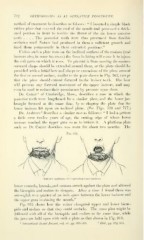Page 794 - My FlipBook
P. 794
792 ORTHODONTIA AS AN OPFJIATIVE PROCEDURE.
metlio
ened portion in front to receive the thrust of the six lower anterior
teeth .... The posterior teeth were thus prevented from forcible
occlusion until Nature had produced in them a sufficient growth and
fixed them permanently in their extended positions."
Unless such a plate rests on the inclined surfaces of the canines (and
incisors also, in some instances) the force in biting will cause it to injure
the soft parts on -which it rests. To prevent it from moving the canines
outward clasps should be extended around them, or the plate should be
provided with a labial bow and clas])s or extensions of the plate around
the first or second molars, similar to the plate shown in Fig. 762, except
that the ])late should extend forward to the incisor teeth. The bow
will ])revent any forward movement of the u])per incisors, and may
even be used to reduce their prominence by pressure upon them.
Dr. Cutter^ of Cambridge, Mass., describes a case in which the
posterior teeth were lengthened by a similar plate, and the lower jaw
brought forward at the same time, by so shaping the plate that the
lower incisors bit upon an inclined plane. (See Figs. 776 and 777.)
Dr. Andrews ^ describes a similar case as follows : " I had a patient
a little over twelve years of age, the cutting edge of whose lower
incisors touched the upper gum so as to irritate it. A platform plate
such as Dr. Cutter describes was worn for about two months. The
Fig. 811.
Writer's appliance for depressing lower incisors.
lower centrals, laterals, and canines struck against the plate and allowed
the bicuspids and molars to elongate. After a time 1 found there was
one-eighth to a quarter of an inch space between the lower incisors and
the upper gum in closing the mouth."
Fig. 695 shows how the writer elongated upper and lower bicus-
pids and molars so that they could occlude. The same plan might be
followed with all of the bicuspids and molars at the same time, while
the jaws are held open with such a ])late as that shown in Fig. 810.
1 International Dental Journal, vol. xv. pp. 353-355. '' Ibid., pp. 382, 383.


